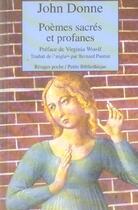-
Date de parution : 06/06/2001
-
Editeur :
Adult Pbs
-
EAN : 9780140422092
-
Série :
(-)
-
Support :
Papier
-
Nombre de pages : (-)
-
Collection :
(-)
-
Genre :
(-)
-
Thème :
Non attribué
-
Prix littéraire(s) :
(-)
Résumé:
B>''The first poet in the world in some things'', is how John Donne was described by his contemporary Ben Jonson. /b>br>br>Yet it is only this century that Donne has been indisputably established as a great poet--and even, many feel, the greatest love poet of them all. Jonson went on to remark... Voir plus
B>''The first poet in the world in some things'', is how John Donne was described by his contemporary Ben Jonson. /b>br>br>Yet it is only this century that Donne has been indisputably established as a great poet--and even, many feel, the greatest love poet of them all. Jonson went on to remark that ''That Donne, for not keeping of an accent, deserved hanging'', yet Donne''s rhythms, once thought ''unmusical'' are now recognized as the natural rhythms of the speaking voice; his ''eccentricity'' as a complex self-doubt; his ''obscurity'' the reflection of a brilliantly learned and allusive mind. Poets such as Eliot and Empson have found Donne''s poetry profoundly attuned to our modern age, while Yeats'' glowing comment will always be true: ''the intricacy and subtlety of his imagination are the length and depth of the furrow made by his passion.'' br>br>This volume, superbly edited by Professor Smith, is the first complete edition to make a serious attempt to guide the reader closely through the complexities of Donne''s poetry. Considerable attention has been paid to the text, and a selection of the important manuscript variants are included. This edition is also the first to make use of the newly discovered manuscript of the verse letter to Lady Carey and Mistress Essex Rich.br>br>For more than seventy years, Penguin has been the leading publisher of classic literature in the English-speaking world. With more than 1,700 titles, Penguin Classics represents a global bookshelf of the best works throughout history and across genres and disciplines. Readers trust the series to provide authoritative texts enhanced by introductions and notes by distinguished scholars and contemporary authors, as well as up-to-date translations by award-winning translators.
Donner votre avis
















